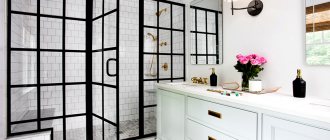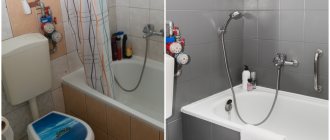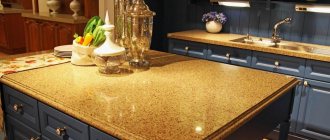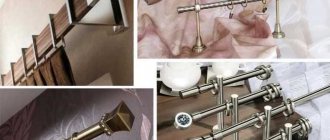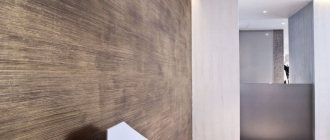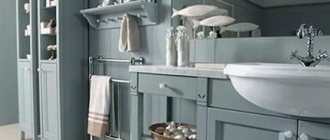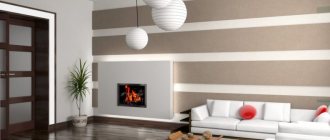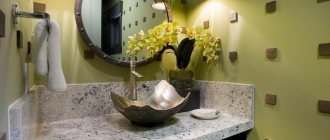Painting bathroom walls instead of tile is back in fashion. This affordable material allows you to carry out high-quality renovation work indoors without the involvement of a team of finishers, and for a person with the makings of a designer, this is also an opportunity to realize his creative potential.
The building materials market offers a wide selection of coatings for different surfaces. Painting a bathroom will not take much time, and the result will not disappoint if you understand the intricacies of this process in time and choose the appropriate composition.
Modern materials allow you to create a unique design for your bathroom using painting.
Latex and acrylic coatings
These water-dispersion paints are ideal for updating bathroom walls and are popular due to the following properties:
- durability and abrasion resistance;
- the presence of special additives that prevent the proliferation of fungal bacteria;
- the ability to obtain a matte coating that masks small roughnesses of the walls, and also makes water splashes and stains almost invisible;
- absence of a pronounced unpleasant odor;
- Easy to use, these paints do not require any special professional skills.
The cost of a latex-based mixture is significantly higher than that of acrylic, but both the quality and appearance of the coating justify this difference. Latex paint is characterized by increased elasticity, the ability to smooth out small chips and tighten small cracks. The service life is from 10 to 15 years.
Waterproof acrylic paint for the bathroom is suitable for painting any surfaces except metal, and this coating will last 7-10 years.
How to paint a bathtub with defects? What formulations are best suited for this?
Unlike plastic and steel products, a cast iron bathtub can last at least 50 years while maintaining its characteristics. It is durable and retains heat well. But even with careful care, the enamel coating is not able to maintain its newness throughout this entire period.
As a result of intensive use, various defects appear on the bathtub coating:
- yellowness caused by sedimentation of iron contained in water;
- chips that appear due to the use of aggressive detergents and temperature exposure;
- cracks that appear as a result of impacts and falling of heavy objects.
The walls of the bathroom in the attic are painted with white waterproof paint
Dyes are used to restore the whiteness and integrity of the coating of a cast iron bathtub. Of course, serious requirements are put forward for such compositions:
- water resistance and ability to withstand constant contact with liquid;
- resistance to low and high temperatures;
- resistance to aggressive detergents.
Two types of paints meet these requirements: epoxy and acrylic enamel.
Helpful advice! To update the coating, experts advise buying acrylic paint for the bathtub; the price of such a restoration is 5 times less than the cost of a new bowl. Such savings can be achieved if the composition is applied with your own hands.
To restore a cast iron bathtub, two types of compositions are used: epoxy and acrylic coating
Restoring the coating using epoxy paint for a cast iron bathtub
Epoxy enamel is widely used for the restoration of bathtubs. This product has already been tested and is perfect for painting bowls at home. However, preparing the composition for work requires complex manipulations. Therefore, not every consumer will risk buying epoxy-based paint for a cast-iron bathtub.
The fact is that in addition to the base, the dye contains a hardener and plasticizer. Dibutyl phthalate is used as a component providing plasticity. Thanks to it, the dye is thick and viscous. Without the appropriate experience and special tools, it is quite difficult to apply such a coating to the surface of the bathtub and obtain a uniform layer. Therefore, work of this kind is performed only by professionals.
Average prices for bathtub enamel with BASF dye:
| Package of services | Number of layers | price, rub. |
| Social | 2 | 2450 |
| Standard | 2 | 2700 |
| Reliable | 3 | 3500 |
Features of using acrylic paints for the bath, prices for restoration
Liquid acrylic has been used for the restoration of bathtubs relatively recently. Professionals claim that this dye has almost the same performance characteristics as epoxy enamel.
Acrylic is suitable for painting cast iron paint at home without the help of specialists. Although preparing a high-quality mixture requires some effort. Due to the high viscosity of the dye, it must be stirred for a very long time and thoroughly before application. Moreover, the mixture consists of a hardener and a base. No plasticizer is used in its preparation. This is what distinguishes acrylic dye from epoxy enamel.
The hardener has a liquid consistency, while the acrylic base is thick. A homogeneous substance is applied to the surface of the bath, so the mixture is stirred until it becomes fluid. In this case, the dyeing process itself is greatly simplified. Although, compared to epoxy enamel, restoration using acrylic paint will be more expensive.
Average prices for bathtub restoration using Stacril Ecolor liquid acrylic:
| Package of services | Drying time, h | price, rub. |
| Stacril Ecolor | 36 | 2500 |
| Stacril Ecolor 2012 | 36 | 2750 |
| Stacril Ecolor 2015 profi | 16 | 3250 |
| Restoration using Finnacryl liquid acrylic | ||
| Finnacryl | 24 | 2850 |
| Finnacryl 2010 | 24 | 3400 |
| Finnacryl 2015 | 16 | 3900 |
| Finnacryl 2015 | 8 | 4550 |
Note! The prices indicated in the tables include a specialist’s visit to your home, treatment of the bathtub, costs for consumables, as well as the work of specialists in applying acrylic or epoxy enamel to the surface of the bowl in one layer.
Silicone and silicate coatings
Painting your bathroom walls yourself can be a pleasure if you work with modern materials. Silicone-based paints can be classified as such materials, since their characteristics fully meet the requirements for finishing bathrooms and other rooms with high humidity:
- high resistance to mechanical damage;
- moisture resistance;
- the possibility of application even on non-ideal surfaces, the ability to cover significant flaws in the form of deep cracks and other irregularities;
- attractive appearance of the coating.
The guaranteed service life of the material is 15-20 years or more. Silicone paints are not only of high quality, but also of an appropriate price, so they cannot be called the most popular, especially since there are many options for what paint to paint a bathroom with.
Laconic and stylish
Painting the bathroom
Once the bathroom painting design is determined, the painting technology becomes clearer. The lesson of a single-color coating is easier than applying different colors; the following steps are performed:
- The paint mixes well.
- If necessary, color is introduced.
- First, paint the joints in the corners and hard-to-reach areas using a narrow brush.
- Afterwards, the main areas are painted with a roller or wide brush.
- When the first layer dries well, apply the second. The number of layers is determined based on the obtained quality of wall painting.
When the first layer dries well, apply the second.
Oil paints and enamels
It is impossible not to mention these materials, since walls painted with oil paint can still be found in some rooms, however, we have to admit that this method of finishing a bathroom has long been outdated and has a large number of disadvantages:
- the paint takes a very long time to dry (two days);
- a pungent odor that is difficult to dissipate can cause headaches and poisoning;
- even after drying, the coating continues to release toxic substances, including carcinogens;
- oil paint has zero vapor permeability, which increases humidity in any room and, as a result, the appearance of mold;
- the coating is not elastic, so it begins to crack when temperature changes;
- The drying oil that is part of the material turns yellow over time, which leads to a change in the original color of the walls.
To be fair, it should be noted that oil paints and enamels are excellent for coating metal structures: they protect against rust, as well as for exterior finishing work. At a price, these compositions are more than affordable. This coating will last a relatively short time - from one and a half to five years. If this option suits you, read more about how to choose oil paint.
Color spectrum
When painting a bathtub, design plays an important role; you need to choose the optimal shade so that it matches the rest of the decor in the room. Often the room is small in size; to visually enlarge the space, light colors are chosen.
The choice of color is made mainly taking into account the preferences of the owners. If a monochrome combination is used, then the color of the walls should match the pastel colors of the wooden furniture. If you want to create a brighter interior, use different colors, from three, but no more than six.
When painting a bathtub, design plays an important role; you need to choose the optimal shade so that it matches the rest of the decor in the room.
Water emulsions
Water-based paint for bathrooms is a justified choice. You get good results at a low price. Advantages:
- environmentally friendly material is harmless to health;
- has no unpleasant odor;
- the coating dries quickly;
- working with water-based emulsion is very easy even for a beginner;
- it is possible to experiment with shades, mixing and adding any colors as desired;
- due to its low cost and ease of use, you can renew indoor walls using water-based paint at least every year;
- the composition of decorative paint will allow you to implement different design solutions by applying graphic ornaments or designs to the surface using stencils and other devices.
The material can be intended for finishing dry or wet rooms; you need to pay attention to this when purchasing. The coating can also be matte or glossy. The first visually expands the space and smoothes out small blemishes on the painted surface, while the second, on the contrary, emphasizes all the irregularities, but gives a slight mirror effect and is more resistant to abrasion.
Water-based bathroom paint also has disadvantages. For example, the coating will not last long if it is washed frequently using even gentle products (laundry soap).
However, on modern shelves you can also find water-based paints that contain special components that increase the durability of the coating. These paints can protect and decorate walls for 5 to 10 years.
Painting can be combined with tiles and other materials
Decorative painting methods
Creating drawings with your own hands is not accessible to many; a complex process can be replaced by using stencils, or using other decorative methods for obtaining an original design.
Creating drawings with your own hands is not accessible to many; a complex process can be replaced by using stencils.
Using stencils
A stencil is a convenient option to create beautiful patterns on the wall. They come on a self-adhesive base; if there is none, then a stencil is attached to the surface painted in the main tone using masking tape. The shade chosen for the drawing is rolled with a roller; it is important to paint the areas well in order to get a clear image.
It is important to paint the areas well to get a clear image.
Striped walls
Creating stripes on the surface helps to increase space and create an unusual design in the room. What width and color to choose depends on the wishes of the master; there are no restrictions in this regard. The boundaries of the strip are marked with masking tape to make straight lines.
Creating stripes on the surface helps to increase space and create an unusual design in the room.
Rollers for applications
This tool allows you to quickly apply a pattern to a surface. After the base layer has dried, work begins with an appliqué roller. It is necessary to move the tool evenly so that the pattern is applied evenly; the second strip of patterns should fit snugly against the first.
It is necessary to guide the tool evenly so that the pattern is applied evenly.
Chlorine rubber paint
The latest super durable material. It was originally intended for painting swimming pools, and is now used in finishing bathrooms. Positive points:
- absence of toxic impurities in the composition,
- durability,
- water-repellent coating,
- easy care.
It would seem like an ideal option, but, alas, this moisture-resistant paint for the bathroom is not always suitable. Only metal surfaces or cement can be painted with chlorinated rubber. The presence of putty or other material is unacceptable.
In addition, this coating does not like overheating, the maximum operating temperature is + 27 ° C. Service life – up to 10 years.
So, which composition is best to paint the walls in the bathroom, you can choose based on the characteristics of a particular room, your own preferences and budget. In any case, it will not be possible to do without preliminary surface treatment. More on this later.
Is it possible to do without ceramic tiles?
When decorating bathrooms, you can do without ceramic tiles, since there are now many other materials on the market that protect walls from moisture.
In addition to ceramics, there are porcelain stoneware, natural stone, moisture-repellent panels and special impregnations. Let's take a closer look at the latter.
Special impregnations are used to eliminate the risk of mold and protect porous surfaces from moisture. These are hydrophobic compounds that penetrate deeply into the wall material.
Such materials have appeared relatively recently and their use allows expanding the options for finishing wet areas of the apartment.
Work order
Preparing bathroom walls for painting depends on their initial condition and includes several stages.
Cleansing
- Sometimes it is enough to thoroughly rinse and dry the surface. This option is possible if the walls were recently painted, and the coating is perfect, but you just want to refresh it or change the shade.
- When the paint has come off a little in some places, but overall it holds and looks good, you can clean the problem areas with a spatula, wash the wall and dry it.
- If the bathroom wall covering is in poor condition, you will have to get rid of it completely. The most difficult thing to deal with is old oil paint. To do this, you can choose from simple tools (an axe, spatula, chisel, scraper), electrical appliances (drill, hammer drill) with special attachments, a hair dryer, or chemical compounds (washes). You can read more about how to remove oil paint from a wall in a special article.
Alignment
Before covering the bathroom walls with a paint composition, they often have to be leveled. This need arises if the surface has been actively cleaned or simply has large and small flaws. How to do it:
- A special primer is applied to the cleaned surface to ensure good adhesion of the material to the wall.
- After the solution has dried, all deep cracks, potholes (if any) and irregularities are filled with putty, leveling the surface as much as possible. Wait for it to dry completely again.
- Rub the putty areas with sandpaper and wipe off dust.
- Minor defects are corrected with a soft and flexible finishing putty; After drying, sand with fine-grain sandpaper.
When the process is completed, the entire room needs to be vacuumed and wet cleaned so that there is no construction dust left on the walls.
Primer
When purchasing bathroom paint, it is advisable to immediately stock up on primer. Treating walls with this solution reduces the consumption of base material, protects the coating from stains, improves the adhesive properties of the surface and prevents the growth of fungal bacteria.
For the primer you will need a tray, a paint roller and a brush for working in corners and hard-to-reach places. The technology is simple: you need to completely cover the surface intended for further painting with the composition, and then let it dry.
Tools
To prevent painting the walls in the bathroom from becoming a challenge, it is important to provide yourself with good tools. To carry out the work you will need a standard set of painting tools:
- a paint tray (cuvette) with a special ribbed platform, where it is convenient to remove excess paint from the roller;
- paint roller of appropriate size;
- wide brush for painting corners;
- a narrow brush that can easily get around sockets and switches;
- telescopic handle for a roller, stepladder or stool;
- masking tape to protect surfaces that cannot be painted, such as joints with the ceiling.
When coming into contact with oil paint, it is necessary to protect the respiratory system from toxic fumes, and also stock up on rags and solvent in order to immediately remove accidental contamination, which is rarely possible to do without. Hair can be hidden under a paper cap or scarf, hands covered with gloves, and work clothes should be comfortable.
What is better to paint
You can apply paint with a spray gun, brushes and roller. The first tool will give quick and high-quality results, but it is expensive and also requires certain operating skills.
Brushes are used only for hard-to-reach areas; it will be difficult to cover all the walls with them, and the process will be delayed. Rollers allow you to more quickly and evenly apply the composition to the walls.
You can apply paint with a spray gun, brushes and roller.
What solutions are odorless?
Alkyd and oil types have many advantages, the main ones being resistance to moisture, but their main disadvantage is a very unpleasant odor, which even after drying lasts inside the building for a long time. Accordingly, the repair will be delayed.
Odorless paints are those that are produced using water rather than thinners. So these are water-based and water-dispersed compositions. In addition, they are quick-drying, the wall can be repainted several times if necessary, and the interior can be updated more often.
Odorless paints are those that are produced using water rather than thinners.
